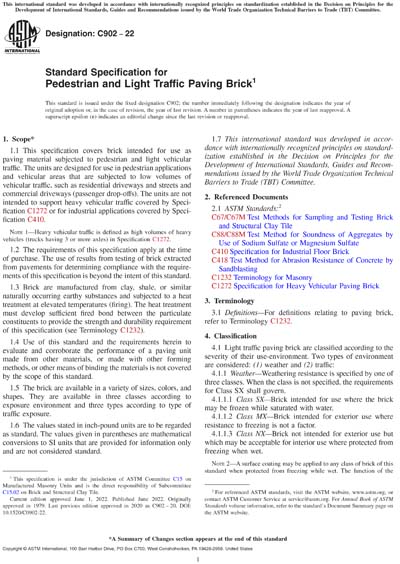Most recent
ASTM C902-22
Standard Specification for Pedestrian and Light Traffic Paving Brick
1.1This specification covers brick intended for use as paving material subjected to pedestrian and light vehicular traffic. The units are designed for use in pedestrian applications and vehicular areas that are subjected to low volumes of vehicular traffic, such as residential driveways and streets and commercial driveways (passenger drop-offs). The units are not intended to support heavy vehicular traffic covered by Specification C1272 or for industrial applications covered by Specification C410.
Note 1:Heavy vehicular traffic is defined as high volumes of heavy vehicles (trucks having 3 or more axles) in Specification C1272.
1.2The requirements of this specification apply at the time of purchase. The use of results from testing of brick extracted from pavements for determining compliance with the requirements of this specification is beyond the intent of this standard.
1.3Brick are manufactured from clay, shale, or similar naturally occurring earthy substances and subjected to a heat treatment at elevated temperatures (firing). The heat treatment must develop sufficient fired bond between the particulate constituents to provide the strength and durability requirement of this specification (see Terminology C1232).
1.4Use of this standard and the requirements herein to evaluate and corroborate the performance of a paving unit made from other materials, or made with other forming methods, or other means of binding the materials is not covered by the scope of this standard.
1.5The brick are available in a variety of sizes, colors, and shapes. They are available in three classes according to exposure environment and three types according to type of traffic exposure.
1.6The values stated in inch-pound units are to be regarded as standard. The values given in parentheses are mathematical conversions to SI units that are provided for information only and are not considered standard.
1.7This international standard was developed in accordance with internationally recognized principles on standardization established in the Decision on Principles for the Development of International Standards, Guides and Recommendations issued by the World Trade Organization Technical Barriers to Trade (TBT) Committee.
Content Provider
ASTM International [astm]






